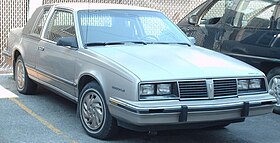Pontiac 6000
| Pontiac 6000 | |
|---|---|
 |
|
| Overview | |
| Manufacturer | Pontiac (General Motors) |
| Production | 1982–1991 |
| Assembly |
Oklahoma City, Oklahoma, United States Lakewood Heights, Georgia, United States Tarrytown, New York, United States Oshawa, Ontario, Canada |
| Body and chassis | |
| Class | Mid-size |
| Body style | 2-door coupe 4-door sedan 4-door station wagon |
| Layout | Transverse front-engine, front-wheel drive / all-wheel drive |
| Platform | A-body |
| Related |
Buick Century Chevrolet Celebrity Oldsmobile Cutlass Ciera |
| Powertrain | |
| Engine | 2.5 L LR8 I4 2.8 L LE2 V6 2.8 L LH7 V6 2.8 L L44 V6 2.8 L LB6 V6 3.1 L LH0 V6 4.3 L LT7 diesel V6 |
| Transmission | 3-speed 3T40 automatic 4-speed 4T60 automatic 5-speed Getrag manual |
| Dimensions | |
| Wheelbase | 104.5 in (2,654 mm) (1982–1988) 104.9 in (2,664 mm) (1989–1991) |
| Length | 188.9 in (4,798 mm) 193.2 in (4,907 mm) (wagon) |
| Width | 72 in (1,829 mm) |
| Height | 53.7 in (1,364 mm) 54.1 in (1,374 mm) (wagon) |
| Chronology | |
| Successor | Pontiac Grand Prix (Sedan) |
The Pontiac 6000 is a mid-size car that was introduced by Pontiac in 1981 for the 1982 model year, positioned between the smaller Phoenix and the slightly upscale Bonneville (previously the Le Mans). It shared its platform with the Buick Century, Chevrolet Celebrity, and Oldsmobile Cutlass Ciera.
In 1978, GM had introduced downsized RWD midsize cars on the A-body platform (Chevrolet Malibu, Pontiac Le Mans, Oldsmobile Cutlass, and Buick Regal). Then in 1982, a new line of separate FWD midsize cars were introduced, also referred to as A-bodies, but actually based on the compact X-body platform. Since GM had not monetized the tooling costs of the RWD A-body platform, they were forced to continue producing them alongside the newer FWD models.
The 6000 was built at the Oshawa Car Assembly plant in Ontario, Canada from 1981 to 1988 and in the Oklahoma City Assembly plant in Oklahoma until production ceased in 1991. They were also made in Tarrytown, New York for a few years. By 1984 the 6000 was Pontiac's best seller, with over 122,000 units sold. Since the demise of the 1000 after the 1987 model year, the 6000 was the last remaining Pontiac to bear the "000" in its name (the 2000 Sunbird was the first Pontiac to drop it in 1985).
In 1982, two trim levels were offered: 6000 and 6000 LE. Both came standard with the new-for-1982 2.5 L (151 cu in) Tech IV four-cylinder with throttle body injection. It made 90 horsepower (67 kW). Optional engines were GM's 2.8 L (173 cu in) V6 with a 2-barrel carburetor which made 112 horsepower (84 kW), or a 4.3 L (263 cu in) Oldsmobile diesel V6 which made 85 horsepower (63 kW). The diesel engine was problematic and unpopular and was discontinued in 1985. The 2.8 was updated for 1985 with multi-port fuel injection, raising output to 135 horsepower (101 kW) exclusively for the STE. The fuel-injected 2.8 made its way into the Base and LE models for 1986, however in these trims it only made 125 hp. The Tech IV was given various updates over the years but was mostly unchanged. For 1984, a station wagon known as the 6000 Safari was introduced to replace the rear-wheel drive Bonneville Safari wagon. In 1987, an S/E model arrived with the STE powertrain but fewer features, and the quad-rectangular headlamps were replaced with the composite headlamps. In 1989, the coupe model was dropped, and the 6000 received a more-rounded roofline with the Buick Century and Oldsmobile Cutlass Ciera, and was facelifted for the final time with slightly wider headlamps and a new grille. In 1990, passive front seatbelts were introduced and a 3.1 L (191 cu in) V6 replaced the 2.8. After the STE model was dropped from the 6000 line for 1990, the S/E model gained its all wheel drive option. This was later dropped for the 1991 model year. The 6000 was dropped after 1991, replaced by the Grand Prix sedan. In addition, the Pontiac 6000 wagon was the final GM designed station wagon offering from Pontiac, as it was replaced by the Pontiac Trans Sport in 1990.
...
Wikipedia
